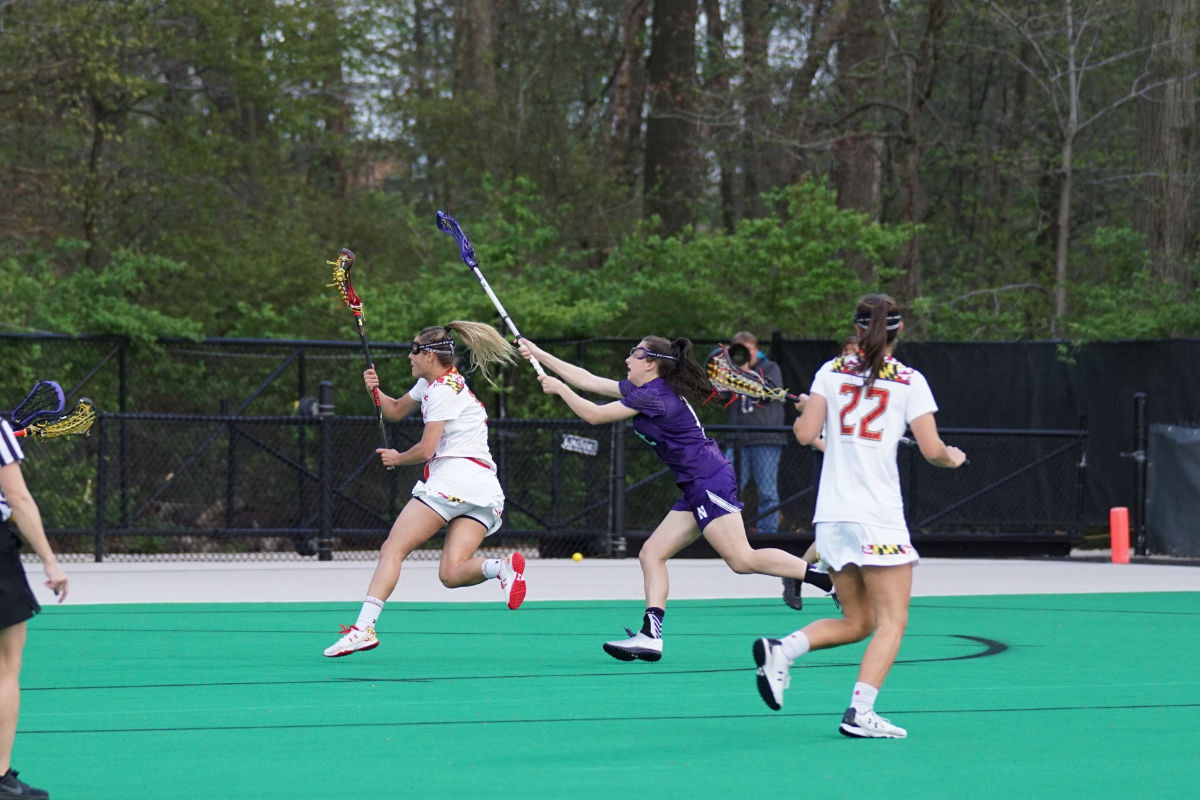If you’re at all familiar with the concept of soccer positions (or most field sports really) and how the field is set up, getting a feel for the lacrosse field will be easier for you than if you’ve never played a field sport before. However, if you’re a complete beginner to the world of field sports, you’re in the right place. Having the bird’s eye view of women’s lacrosse positions explained to you before you step on the field will make all the difference and will remove some of that fear that comes from simply not knowing what you’re doing.
Each group of players on the field has specific duties and focuses, but to be a good team player, it’s important to understand what all of your teammates should be doing as well. Another great article to read alongside this one is “The Field Explained”; it’ll help to create a better picture in your mind as we go through the different roles of the team and why they’re all important.
In total, there are 12 positions on the field for each side, and they make up the offense, defense, midfield, and of course the goalkeeper. Let’s look at each of those a bit more closely.
Offense Positions in Women’s Lacrosse
The core of offense, or what we call low A or attack, is made up of three players who start out on the restraining line in the opposing team’s zone at the beginning of every draw. These girls’ job is to put the ball into play once their team has possession. Sometimes there is an immediate shot on goal, especially from a quick transition, and sometimes the defense will be ready, in which case you will have to settle in their zone and start a play. Plays usually look like passing the ball around the 12-meter until there’s an opportunity for a breakaway to goal and you can score! There are an infinite amount of plays that you can incorporate that switch up the pattern of passing. The main thing is simply to catch the defense off guard so that there is an opportunity to score. As you get more comfortable with your team and as your stick skills improve, you can improvise these plays which is always a lot of fun.
Offensive Players and Stick Skills
Offensive players typically have very strong stick skills. Being able to switch between your dominant and non-dominant hand to protect the ball from defenders is very important and should become an automatic maneuver for you. While you’re cradling, always remember the phrase “shoulder, shoulder, ball.” The ball should always be the furthest thing away from the defender, and your two shoulders should always be the buffer between your defender and the ball in your net. Protecting the ball like this, while also looking for a pass or a shot on goal will definitely take some practice, but should be something you’re comfortable doing.
X Position
Sometimes, during plays, an offensive player will drop down to a position we call “X,” which sits just behind the goal. From behind the goalie, this girl can feed passes to her teammates who are cutting through the 8-meter, without having the immediate pressure from a defender. Being behind the goal usually gives the offensive player a little bit of space so that she can scope out any possible outlets for a pass. The X position is typically the leader of the play; this person needs to have a good eye, and the confidence, for strong passes that can keep the defenders on their feet. Many times, a second girl can drop down behind the goal and these two players can pass to each other until one can roll the crease for a close shot.
Midfield Positions
In order to get to the opposing team’s zone, it first needs to get through the midfield. The midfield area is the middle third of the field where the circle is located. This is where draws occur and where five of your teammates will start off. Midfield typically consists of one center, two defense wings (D-wings), and two offense or attack wings (A-wings). These players are in charge of transitions and, typically, making sure the team isn’t offsides. If you’re interested in playing a little of everything, midfield might be the thing for you, like it was for me, but get ready to run!
The Draw
At the start of each half and after each goal, the centers will perform a draw at the center point of the field. This is when the two centers will press the ball in between the backs of their crosses until the ref blows the whistle. When the whistle is blown, the two girls will swing their sticks above their heads, in an attempt to get the ball above their shoulders, and over to a teammate or to herself where she can nab it in the air before the opponent. Once the scuffle for the ball is over, the entire field needs to be prepared to either transition into offense or defense. Low A needs to settle into play position, or get open for a pass, in order to keep the momentum of the play going, while Low D will have to figure out who is guarding who. The draw plays an important part of who keeps control of the ball, so fight hard during those scuffles and groundballs.
Transitions
Midfield is in charge of a quick, seamless transition. After the draw, the midfielders need to get the ball to the opposing zone as fast as possible. The more momentum a team has from a quick transition, the easier it will be to catch the defense off-guard and you can go straight to goal. If there’s a turnover in one zone, midfield must be at the ready to easily and quickly get it to the other side. Sometimes players will be wide open, and passing the ball down the field will be your go-to. Other times, especially if the D-wings are playing strong defense, you might have to simply run it down the field.
D-Wing vs A-Wing
These positions will differ in where they spend most of their time by who has possession of the ball. If their team has the ball, the A-wings will be in the opposing zone to work on plays with the low A, cutting through the 8-meter in an attempt to score. Meanwhile, the D-wings will be in their own zone to guard the other team if they have possession. However, in transitions, all midfielders should be playing both defense and offense, so they should be well-versed in both scenarios. They should be good at passing and catching while running, as well as guarding girls on the move. In some instances, sliding and double teaming are necessary, so communication with their teammates is very important. Communication between ANY teammates is important.
Defense Positions
On the off chance that your team loses possession, the ball will make its way into your own zone. You will have to do everything in your power to stop the ball from getting into the goal. Being a defender requires some confidence and a strong sense of owning your space. You must be between the ball and your goalie the entire time the ball is in your zone. Most of the time you will simply have to be marking, or guarding, a girl. Sometimes, in certain age-appropriate leagues, checking is allowed, and should always be done away from the body and when there is a very clear chance.
Defenders should also have a finely tuned communication system. Yelling out who is guarding who and any possible help that you might need, is a great way to avoid any breakaways to goal. It’s also a good way to know where the ball is at all times; spacial awareness is important in defense.
Body Positioning in Defense
How you guard a girl is dependent on whether or not she has the ball. If she doesn’t have the ball, or is simply jogging around the 12-meter, you can usually ease up on how much pressure you put on her. She isn’t an immediate threat to goal, so playing hard defense might be unnecessary. In these cases, one hand on your stick and one hand pointing towards the ball should be enough. Your hand should be placed at the bottom of your stick so that it can be high in the air; this can act as a deterrent for any passes. In the case where your player receives a pass, you’ll be able to knock down the ball since your hands are in ready position. Pointing to where the ball is is another great way to keep track of where it’s moving. You can also typically give your player more space if she doesn’t have the ball.
The most pressure should be placed on the player with the ball. Wherever the ball-holder is, that’s where the hard defense should come into play. You should be tight on the player, giving her less space gives her less opportunity to make passes or dodge towards the goal. Communication is huge in defense, especially if you’re guarding the ball and the player decides to go for goal. You can yell to the closest teammate for an extra hand to double team. Every measure should be taken if a player is attempting to score on goal; all defenders should rush the 8-meter, safely, to try to stop a shot.
Zone Defense vs. Man on Man
There are two main schools of though when it comes to defense styles in lacrosse, and we will go into more detail on the topic in another article. However, the main idea of zone defense is to work as a wall. As a defender you have a section of the wall to guard, whether it’s the top of the 12-meter or down by the crease, you are in charge of your section. As a ball-holder moves around the 12-meter, she will be passed on from defender to defender. Man on man, on the other hand, is when each player guards one player for the entirety of the play, or until there is a turnover. Less communication is needed for man on man, which may not always be the best idea.
Women’s Lacrosse Positions Explained – Wrap Up
There are a lot of intricacies for each position of the field. Each area takes a certain mindset. If you enjoy improvising, have strong stick skills, and are a little greedy, then maybe offense is something you’ll enjoy. If you are a great communicator and have some confidence in owning your space, then maybe defense is for you. If you’re an indecisive Libra like I am, then you’ll love midfield! Practice is what trying new things is for, so if you’re interested in trying a new position ask your coach to switch things up. I think that knowing what each position does is important, it helps you understand that being a good team is similar to working like a well oiled machine.

